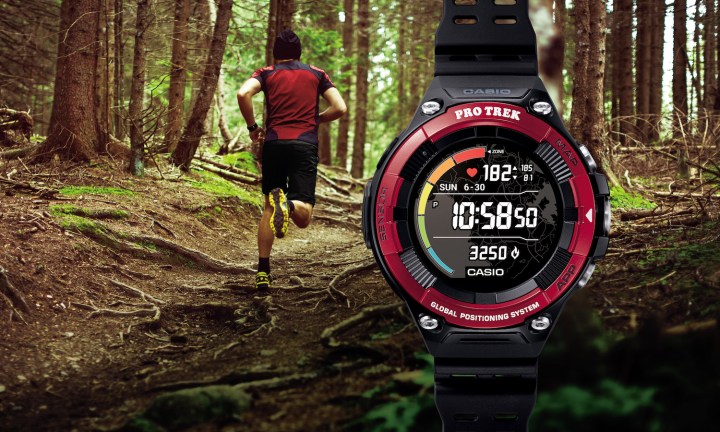
Serious runners and outdoor athletes look to a handful of brands when they want the best wearable to connect them with the outdoors and track their ventures throughout. While Casio may have a place in such discussions, the lack of a heart rate monitor on its wearables seriously hindered that consideration for some. Finally, the newly announced PRO TREK WSD-F21HR changes this with Casio’s first hear rate-enabled smartwatch.
Focused on tracking and facilitating runs, cycles, and climbs via GPS and heart rate monitoring, this $500 Google WearOS-running wearable offers the durability, usability, and range of sensors needed to help you keep track of your exercise and the world around you.
The WSD-F21HR may not have a name that just rolls off the tongue, but it has a list of features that do. Packing an altimeter, barometer, compass, and GPS, the WSD-F21HR has all of the tracking ability of its predecessors, plus the newly added heart rate monitor. This takes real-time measurements to display which of the five heart rate zones you’re in and can be set to appear automatically on the home screen when it senses motion. Trekkers can also keep track of tides and fishing times, as well as sunrise and sunsets, and even follow along previously tracked routes via logged GPS information, all from the watches built-in software.
Casio’s Activity app has also been updated to include menus for running and trail running which show real-time stats for heart rate, pace, and distance. All logged data is saved to Google Drive, with the added ability to view activity history on Google Calendar.
The wearable does run Google’s WearOS, and is therefore compatible with any WearOS-compatible apps, like STRAVA, MapMyRun, and BIKEMAP. This smartwatch is compatible with iPhones, but will have much less third-party features.
The WSD-F21HR is water resistant up to 50 meters and meets the United States Military’s standard for environmental durability with regard to temperature, shock, and humidity.
Coming in black and red colorways, this latest smartwatch also features Casio’s signature dual-layer display which shows time, date, and other tidbits on a monochrome watchface, while underneath lies a 1.32-inch color display with resolution of 320 x 300.
Available for pre-order now, the WSD-F21HR is available through Amazon, Casio, and select retailers for $500 or 400 British pounds in the U.K.. Orders begin shipping September 13.
Updated on August 22, 2019: Added in U.K. price and release date.
Editors' Recommendations
- The best Wear OS apps for your Google-powered smartwatch
- Tag Heuer reimagines its beautiful, $1,800 WearOS smartwatch for 2020
- Hardcore Suunto 7 smartwatch takes on Apple Watch in its toughest race yet
- Mobvoi’s new TicWatch Pro 4G/LTE smartwatch lasts 2 to 30 days with a catch




